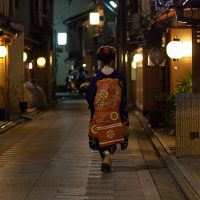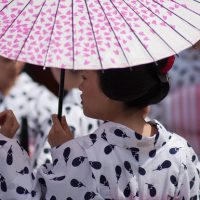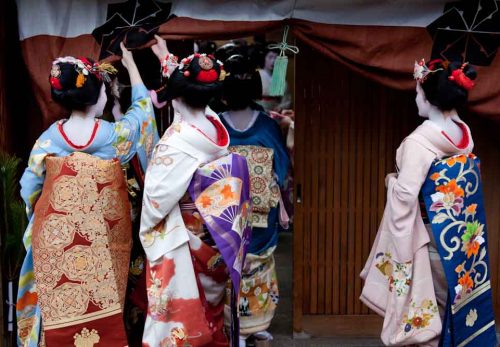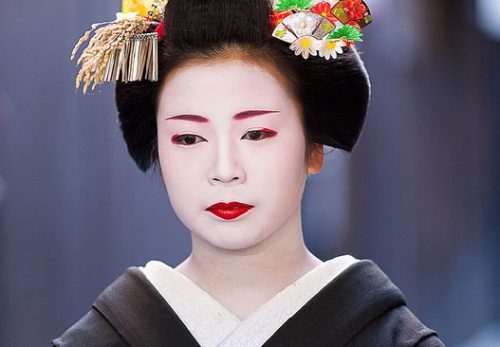June is a rainy season in Kyoto. The long spell of rainy weather in early summer comes and stays for a while.
But the costume for maiko becomes airy and lighter as if it blows the gloom off. They wear Hitoe (light unlined kimono) and obi in Ro (silk gauze obi) this season. It is only June and September when they dress in this kind of outfits.
Junior maiko wear green willow kanzashi (ornamental hairpins) in June. Willow branches swing as they walk on a street of hanamachi. Some senior maiko choose colorful kanzashi which represent hydrangea flowers. Their kanzashi express a short quiet period before a blazing summer of Kyoto.
Speaking of June, there is a big event “Miyako no Nigiwai” (“Bustle of the City”) is held.Geiko and maiko of the five hanamachis get together and show brilliant dance performances here.
Of course, dances by maiko of each town are really wonderful, but I should say the greatest one is ‘Gion Kouta’ which is shown as a finale. Four maikos comes out from each hanamachi, in total there are twenty of them dancing on the same stage.
Its real pleasure is to be able to enjoy different dance styles of different schools on the same stage at the same time. I am sure you’ll enjoy it!
------------------------
“Miyako no Nigiwai”
Special Joint Performance of Traditional Arts by the Five Hanamachi of Kyoto
June 29th (Friday) The first performance
From 2:30 p.m. ? 5:00 p.m.
June 30th (Saturday) The second performance
11:00 a.m. ? 1:30 p.m.
2:30 p.m. ? 5:00 p.m.
Venue: Minami-za Theater (Kyoto Shijo Oh-hashi)
------------------------

Satoryu san of Kamishichiken. As she walks, tasseled Kanzashi (ornamental hairpin) streams softly in the wind

Kimono for Maiko is called ‘Ohikizuri’. It has an extremely long hem like a dolphin’s tail. There is a custom to hold kimono’s hem with left hands whenever they go out
Addition: This is a secret tip to see geiko and maiko up close.
Many of them enter the Minami-za Theater right before the opening time.
Highlight events in Hanamachi,June
●The 3rd
Gion Hojoe at Shirakawa River, Gion
●The 29th – 30th
Miyako no Nigiwai
Special Joint Performance of Traditional Arts by the Five
Hanamachi of Kyoto at Minami-za Theater

Maiko,Kikushino san of Miyagawa-cho
Events in Kyoto,June
●The 1st
Kifune Festival at Kifune Shrine
●The 2nd ~3rd
Takigi-Noh (Bonfire Noh play) at Heian Shrine special stage
●The 3rd
Gion Hojoe at Shirakawa River, Gion
●The 16th
Hojoe (releasing ceremony) for Fireflies at Daikakuji Temple
●The 20th
Bamboo Cut Ceremony at Kurama Temple
●The 23th
Hydrangea Festival at Sanzenin Temple
●The 25th
Birthday Festival of Sugawra no Michizane at Kitano Shrine
●The 29th~30th
Miyako no Nigiwai at Minami-za Theater
●Early
Free public opening of the garden at The garden of Heian Shrine
●Middle
Cormorant fishing at Uji River
●Late
Purification Ceremony of summer at Shrines in Kyoto City

Cormorant fishing at Uji river
June’s column
Tatsumi Shrine is known as the Inari Shrine of Gion. A river called Shirakawa runs right next to the shrine. It is the stage of ‘Gion Hojoe’, a Buddhism ceremony which is held on the first Sunday of June (Inari Shrine is a Shinto shrine that honors Inari, the deity of food).
In a ceremony, people pray and thank for the lives which we eat as food. It is based on teaching, “stop killing, release captive animals”. After high priests of Mount Hiei read the sutras, 2000 young fish are released from the bridge.
Strangely, more birds flock to Shirakawa River than usual on the day. Of course, they try to catch released young fish at a downstream.
They are busy moving their beaks, as if to say “God,bless you!” This might be imprudent but I even think of people who enjoy flowing noodles when I see those birds.
※Flowing noodles: A style of eating noodles in summer. A bamboo flume is set in front of diners. Clear water runs in a flume and noodles come. Diners pluck them out with their chopsticks and eat.
Two maikos from Gion-Kobu attend the ceremony every year. Some people are more interested in taking photos of them than ceremony itself.
I hope that they consider the original purpose of Hojoe, keep good manners, and take good photos of maiko, fresh green leaves, and running water of the river.

Hojoe at Tatsumi Shrine

Maiko, Masaki san of Gion-Kobu
Photos:Copyright(c)2012 Geisha Japan All Rights Reserved
Special Thanks to: WALKKYOTO(some images on this article are provided by http://walkkyoto.exblog.jp/i30/ )










この記事へのコメントはありません。